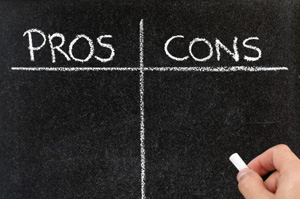
Let’s get real about processing payroll. If you search around a bit on the internet, you will see a huge variety of payroll software vendors and payroll service providers. Each one of them is different, with their own set of features, services, and pricing. Some of the companies you read about or speak to will make claims about how you should be processing your payroll. The truth is that nobody knows what is best for your company and its specific payroll need, unless they get to know you first. There is no ‘one size fits all’ alternative to payroll processing. Payroll has many facets, and no two companies handle it in the same way. Here are some of the commonly found myths about payroll processing, and why they are not true.
-
You will save money by switching to a payroll service or to payroll software.
Sure, one of them might be true. But be skeptical if somebody tells you that you can save money with their system, before they understand your specific needs. Many factors impact the money you spend on payroll processing, just a few of which are your number of employees, method of entering and calculating time, and tax filing method. Making sure your company’s payroll needs are met is more important than saving a few bucks, so make your needs the first priority, and then you can start looking at pricing.
-
When it comes to payroll tax filing, you should (insert method here).
Growing technology has brought us a variety of choices where payroll tax filing is concerned. You can still purchase the forms and mail them (unless your state requires you to file online), but you can now file online or even have the whole process outsourced. How you choose to do this will depend on your state requirements because states are continually lowering the employee threshold where you must e-file or do online forms. Minnesota, for example, requires all employers to e-file or do online reporting when filing quarterly unemployment wages.
-
You should be paying your employees via (insert method here).
I once heard a story about a company who decided to pay their employees via direct deposit, eliminating the printing of payroll checks. Most employees were excited about the change, but one man stated he was extremely angry about it and really wanted to keep getting his printed check. Then the switch was made and, well, it turned out he loved skipping the trips to the bank. (Hey, change can be hard!) You can still print checks, or you can use direct deposit or even pay employees with a debit card. Only you and your employees know which method is best. For instance, you may want to use debit cards for those without bank accounts, and direct deposit for the others. Analyze what works best for your company and your employees, and make the decision based on that analysis.
There are lots of vendors out there providing payroll software and payroll services. Just be sure that before jumping ship on your current method, you look out for your own company’s needs first. Don’t fall prey to the sales rep who uses one of the above blanket generalizations without first understanding your business.

This guest post is by Niklus Vetter, who has been Sales Manager at TSYS smartOne Prepaid Solutions and has been in the payment industry for 6 years, and focused on the prepaid pay card industry for 3 years. smartOne Prepaid Solutions has offered prepaid products since 1997, and created a business unit focused on this product in January 2004. TSYS, now the owner of smartOne Prepaid Solutions as of 2011 has been processing prepaid applications for over 10 years in 17 different countries with 90 million accounts globally.
Red Wing Software is proud to offer payroll customers the ability to pay employees with debit cards, thanks to a partnership with TSYS Merchant Solutions?.Red Wing Software payroll customers, who are using direct deposit, can now pay their employees without bank accounts electronically with a smartOne Pay Card®. Red Wing Software customers have been happy with the service, and we caught up with Niklus from TSYS Merchant Solutions to learn more about how the system works. Here are my questions, along with answers from Niklus about the smartOne Pay Card® solution.
-
Paying employees with debit cards is becoming more and more popular. How does payment via debit card work?
Even with the invention of direct deposit, there has been a gap for employers to be able to pay all employees electronically. Some employees do not have bank accounts or do not wish to have their pay checks direct deposited into their bank accounts, resulting in employers continuing to pay their under banked group of employees with the more manual, costly, and time-consuming paper checks. The pay card closes this gap acting as the receiver of the electronic direct deposit, so regardless of whether an employee has a bank account or whether he or she wants to use his or her bank account to receive their pay, anyone can receive pay electronically with a pay card.
-
Why would an employee want to be paid by pay card, instead of simply a pay check or direct deposit?
If someone has direct deposit, they will more than likely not wish to change to a pay card. They are already receiving their pay electronically. Pay cards are an alternative to paper checks, with great advantages over the traditional paycheck for both the employer and employee. I have an example of these advantages that most people can relate to in one way or another. Years ago before joining smartOne and before the pay card was available, I worked a job in college but since I did not have a bank account, I did not have direct deposit for my paycheck. There were times I was not be able to get anywhere to cash my check on pay day (maybe my shift wouldn't end until after the banks closed), so if I needed money that evening - too bad. I just had a piece of paper in my pocket (my paycheck) that didn't do anything for me, until I took it somewhere to turn into cash. Usually I would have to wait until the next day and would go to a check-casher, pay a percentage of my total check, and get my remaining pay-day money all in cash. When I was finally able to cash the check, I was carrying around my entire pay in cash, which made it easy to lose or even get stolen. And because it was cash, I couldn't buy anything online or over the phone without purchasing and sending in a money order. The pay card would have solved all of this. I would not have even had to do anything on pay day. My pay check would have been loaded to my pay card that morning and I could have used pay card to make purchases anywhere accepting cards. I would have saved the 3 - 4% of my paycheck that I paid to the check-casher with each pay period. I could also have made a withdrawal from an ATM or at an accepting bank for free during business hours if I did need cash, regardless of having an account there. And, with a pay card, I could have replaced the card and protected my money if lost or stolen. I could have also paid for things online or over the phone without the hassle of a purchasing and mailing in a money order.
-
I know some employers worry about lost or stolen pay cards. What features are in place to protect against that?
First of all, the pay card tends to be more of a fixture in the wallet than a paper check, so losses of a prepaid card are statistically a lot less frequent than the loss of a paycheck. If the card is lost, the cardholder calls our 24 hour customer service and reports it as lost or stolen for a replacement. The employee works directly with our customer service to resolve the issue. A new card is issued to the employee and all back-end information (account and routing numbers) stays the same. The employer does not have to deal with the hassle of cancelling payment to a check and reissuing a paycheck to its employee, or even need know of the problem. Also, the zero liability policies for the card companies apply to prepaid cards, resulting in peace of mind for both the employer and employee if a card is lost or stolen.
-
What else should employers know about paying employees with pay cards?
Various states have different rules on employers mandating electronic pay, but whether you mandate electronic payment or offer both electronic and paper check payment options, pay cards are a great alternative for electronic payment. An employer should check on their state’s position on electronic payment. Also, if implementing a pay card program, employees can sometimes be resistant to the initial change, but the satisfaction rate once a pay card program is in place is very high. We have developed best practices for rolling out such programs that will reduce this resistance, and I would be more than happy to help walk any employer looking to implement a smartOne pay card program for their company and employees through the process.

Do you have employees who are paid by piecework? This type of employee payment is typically used in agriculture, manufacturing, and other industries.
Obviously there are both Federal and State minimum wage requirements you must meet as an employer. No matter what method you use to pay your employees, you need to make sure they are earning at least minimum wage. This can be difficult when you are calculating pay via piecework, unless you have the right software.
If you pay employees via piecework, be sure your payroll system has a feature to manage minimum wage adjustments, or in other words, a system that can tell you whether your employees have earned minimum wage. More importantly, if the employee’s piecework has not added up to minimum wage, the system can calculate the difference and add that amount to their pay, so that you are meeting the Federal and State minimum wage requirements.
CenterPoint Payroll Software for business and for agriculture has a minimum wage adjustment feature that can make this task much easier! Save the time and guesswork associated with minimum wage adjustments, and ask us about CenterPoint Payroll today!

If you are searching for payroll solutions, then you have surely realized the necessity to streamline the processes for such an important part of your business. The subject of payroll can be daunting with the timely tax filing requirements, employee benefit tracking, and a whole host of other concerns. What system will be best for you and your business for processing payroll accurately and efficiently?
Manual processing
Of course this is the most basic of payroll solutions! Processing payroll by hand might seem like a good solution at first, in fact, it might not be so bad to start out. But then there comes a point when things like employee benefits, wage calculation, and many other payroll functions are too difficult to track by hand or in a spreadsheet.
Payroll software
Payroll software refers to a software application that is installed at your physical business location. Once the system is installed and working, your data is entered and also stored and accessed from your location and on your computers. Many people like the control offered by keeping the software and data in-house, rather than outsourcing it. Things like accessibility and security are completely within your control.
Payroll Service
Payroll services take some of the burden of payroll processing off the shoulders of the employer. While payroll services vary greatly, one of the key benefits is that the service takes care of the punctual filing of tax payments. Payroll services can also provide other services such as the distribution of employee checks and providing reports.
Only you can decide between payroll solutions and which one is best for your business. Things that go into the decision would be the size of your business, the complexity of your payroll, and how much control you wish to have.
Wendy Velarde, VP of Human Resources at U.S. Water Services, noticed one day that somebody was walking around the office handing out pay stubs to employees. She thought it seemed inefficient and wanted to see if there was a better way. They were using CenterPoint Payroll by Red Wing Software at the time, so she contacted Red Wing Software to learn more about streamlining that process. Shortly after, they began using the electronic publish pay advice feature offered within CenterPoint Payroll. “Employees have been extremely happy with the online access to their pay information,” said Wendy, “Now they can access their pay data anytime.” Wendy also mentioned several situations during which the electronic access to pay advices could have come in handy. “Once during a snow storm, an employee needed access to his pay information, but only a very few employees had made it to the office. Having the pay advice function back then would have given him immediate access to that data, as long as he had access to the internet,” said Wendy. Also, employees all around the U.S. had to wait for their paper pay stub from the corporate office via mail. The employees are now much happier, having immediate access to their pay information instead of waiting for their stub to arrive in the mail. Providing immediate access to their payroll information allowed one family with a son going to college, to access the financial information they needed for their son’s college easily by using the online pay advice system. Wendy added, “Adding the publish pay advice function has been a huge win from an employee perspective, and it has also saved our company time and money.”